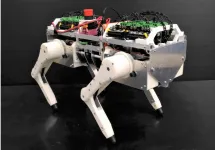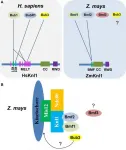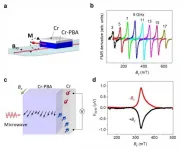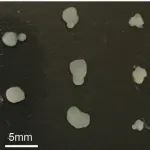MOF metallic mastery
2021-05-11
(Press-News.org) The tightly defined ratios of metals in MOFs makes them ideal starting materials for novel catalyst creation.
Heating bimetallic metal organic frameworks (MOFs) until their porous structure collapses into nanoparticles can be a highly effective way to make catalysts. This novel approach to catalyst design has now been used by KAUST and Spanish researchers to make a robust catalyst that converts carbon dioxide (CO2) into carbon monoxide (CO) gas with unprecedented selectivity.
The benefit of this method pioneered at KAUST is that it can generate mixed metal catalytic nanoparticles that have proven challenging or impossible to make by conventional means.
Capturing CO2 emissions and catalytically converting the greenhouse gas into CO, a valuable chemical feedstock, is one option for reducing greenhouse gases associated with climate change. Precious metals can catalyze this reaction, but they are costly and supplies are limited, says Samy Ould-Chikh, a research engineer in KAUST.
"Iron oxide catalysts are an inexpensive alternative," Ould-Chikh says. "However, in the presence of CO, the iron is carburized forming iron carbide, which leads to by-product formation and catalyst deactivation."
Adding titanium to the catalyst particles could stabilize iron oxide against carburization. Chemical incompatibilities between iron and titanium precursors, however, had made it impossible to synthesize nanoparticles incorporating a homogenous mixture of the two metals in the necessary ratio. To overcome this limitation, the team turned to MOFs, porous materials made from metal ions connected together by carbon-based linkers.
"The use of MOFs allows us to perfectly control the iron-titanium ratio on the parent MOF," says research engineer Adrian Ramirez Galilea. Heating decomposes the organic part of the MOF, leaving the two metals behind, homogenously mixed in the desired ratio and in neat octahedral nanoparticles that mirror the structure of the parent MOF.
The nanoparticles converted CO2 to CO with 100 percent selectivity, with no sign of deactivation after several days of use. "Our initial calculations suggested that nanoparticles with such atomic ratios should be able to do the job; however, the results far exceeded our original expectations," Gascon says.
As well as continuing to explore the properties and reactivity of the iron-titanium nanocatalyst, the team is examining other metal catalyst systems made from MOFs in the same way. "The use of MOFs opens the way to synthesize new catalysts that were not possible to make using conventional approaches," Ramirez Galilea says.
"We are looking at different metal combinations for applications ranging from traditional thermal catalysis to photo and photothermal catalysis," adds Jorge Gascon, who led the research. "This paper is just the tip of the iceberg."
INFORMATION:
ELSE PRESS RELEASES FROM THIS DATE:
2021-05-11
Published today in Nature Communications, the team from the Peter Doherty Institute for Infection and Immunity (Doherty Institute), Alfred Health and Monash University sought to understand which patients would recover quickly from influenza and which would become severely ill.
The four-year project took samples from patients hospitalised with influenza at up to five time points during their hospital stay, and 30 days after discharge. They analysed the breadth of the immune response, enabling them to describe the specific roles of several different types of immune cells, including killer and helper T cells, B cells and innate cells.
University of Melbourne Dr Oanh Nguyen, Research Fellow at the Doherty Institute, said two significant findings of the research include understanding ...
2021-05-11
A group of researchers from Osaka University developed a quadruped robot platform that can reproduce the neuromuscular dynamics of animals (Figure 1), discovering that a steady gait and experimental behaviors of walking cats emerged from the reflex circuit in walking experiments on this robot. Their research results were published in Frontiers in Neurorobotics.
It was thought that a steady gait in animals is generated by complex nerve systems in the brain and spinal marrow; however, recent research shows that a steady gait is produced by the reflex circuit alone. Scientists discovered a candidate of reflex circuit to generate the steady walking motion ...
2021-05-11
Dr. HAN Fangpu's group from the Institute of Genetics and Developmental Biology of the Chinese Academy of Sciences reports the identification and functional study of the maize Knl1 gene in an article published online in PNAS. The gene is a major component of the KMN network that links centromeric DNA and the plus-ends of spindle microtubules. It also plays an important role in kinetochore protein recruitment.
The kinetochore complex that assembles on the centromeres mediates the proper partitioning of chromosomes to daughter cells during the cell cycle. However, kinetochore proteins undergo frequent mutations and coevolve with their interaction partners, leading to great diversity in kinetochore composition in eukaryotes.
Functional ...
2021-05-11
A team of researchers, affiliated with UNIST has recently introduced a new class of magnetic materials for spin caloritronics. Published in the February 2021 issue of Nature Communications, the demonstrated STE applications of a new class of magnets will pave the way for versatile recycling of ubiquitous waste heat. This breakthrough has been led by Professor Jung-Woo Yoo and his research team in the Department of Materials Science and Engineering at UNIST.
Spin thermoelectrics is an emerging thermoelectric technology that offers energy harvesting from waste heat. ...
2021-05-11
Like many around the world, the lab of Professor Mriganka Sur in The Picower Institute for Learning and Memory at MIT has embraced the young technology of cerebral organoids, or "minibrains," for studying human brain development in health and disease. By making a surprising finding about a common practice in the process of growing the complex tissue cultures, the lab has produced both new guidance that can make the technology better, and also new insight into the important roles a prevalent enzyme takes in natural brain development.
To make organoids, scientists take skin cells from a donor, induce them to become stem cells and then culture those in a bioreactor, guiding their development with the addition of growth ...
2021-05-11
COLUMBUS, Ohio - People are more persuaded by the actual messages contained in social media posts than they are by how many others viewed the posts, a new study suggests.
Researchers found that when people watched YouTube videos either for or against e-cigarette use, their level of persuasion wasn't directly affected by whether the video said it was viewed by more than a million people versus by fewer than 20.
What mattered for persuasion was viewers' perception of the message as truthful and believable.
"There wasn't a bandwagon effect in which people were persuaded by a video just because ...
2021-05-11
An international team of researchers at Great Ormond Street Hospital (GOSH), and University of California, Los Angeles (UCLA) have developed a gene therapy that successfully treated 48 out of 50 children with a form of severe combined immunodeficiency that leaves them without an immune system.
Severe combined immunodeficiency due to adenosine deaminase deficiency, also known as ADA-SCID, is a rare, life-threatening disease that prevents children from living a normal life. It is caused by mutations in the gene that creates the enzyme adenosine deaminase, which is essential to a functioning immune system.
Children with ADA-SCID have no immune system and, if left untreated, the condition can be fatal within the first two years of life. Day-to-day activities ...
2021-05-11
An experimental form of gene therapy developed by a team of researchers from UCLA and Great Ormond Street Hospital in London has successfully treated 48 of 50 children born with a rare and deadly inherited disorder that leaves them without an immune system.
Severe combined immunodeficiency due to adenosine deaminase deficiency, or ADA-SCID, is caused by mutations in the ADA gene that creates the enzyme adenosine deaminase, which is essential to a functioning immune system. For children with the condition, even day-to-day activities like going to school or playing with friends can lead to dangerous, life-threatening infections. If untreated, ADA-SCID can be fatal within the first two years of life.
The investigational gene therapy method involves first collecting ...
2021-05-11
CAMBRIDGE, MA -- In early 2020, a few months after the Covid-19 pandemic began, scientists were able to sequence the full genome of the virus that causes the infection, SARS-CoV-2. While many of its genes were already known at that point, the full complement of protein-coding genes was unresolved.
Now, after performing an extensive comparative genomics study, MIT researchers have generated what they describe as the most accurate and complete gene annotation of the SARS-CoV-2 genome. In their study, which appears today in Nature Communications, they confirmed ...
2021-05-11
A receptor that helps conserve energy when food is scarce may be the key to a safer approach to treating diet-induced obesity, research led by the Garvan Institute of Medical Research has revealed.
In a study using experimental models and fat tissue biopsies from obese individuals, the team revealed that blocking a specific receptor of the molecule neuropeptide Y (NPY), which helps our body regulate its heat production, could increase fat metabolism and prevent weight gain.
"The Y1 receptor acts as a 'brake' for heat generation in the body. In our study, we found that blocking this receptor in fat tissues transformed the 'energy-storing' fat into 'energy-burning' fat, which ...
LAST 30 PRESS RELEASES:
[Press-News.org] MOF metallic mastery





